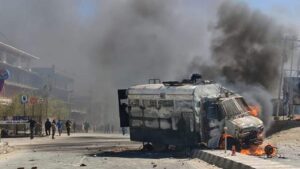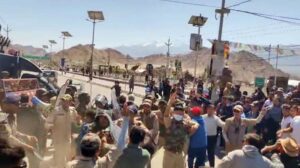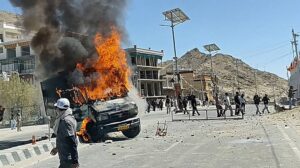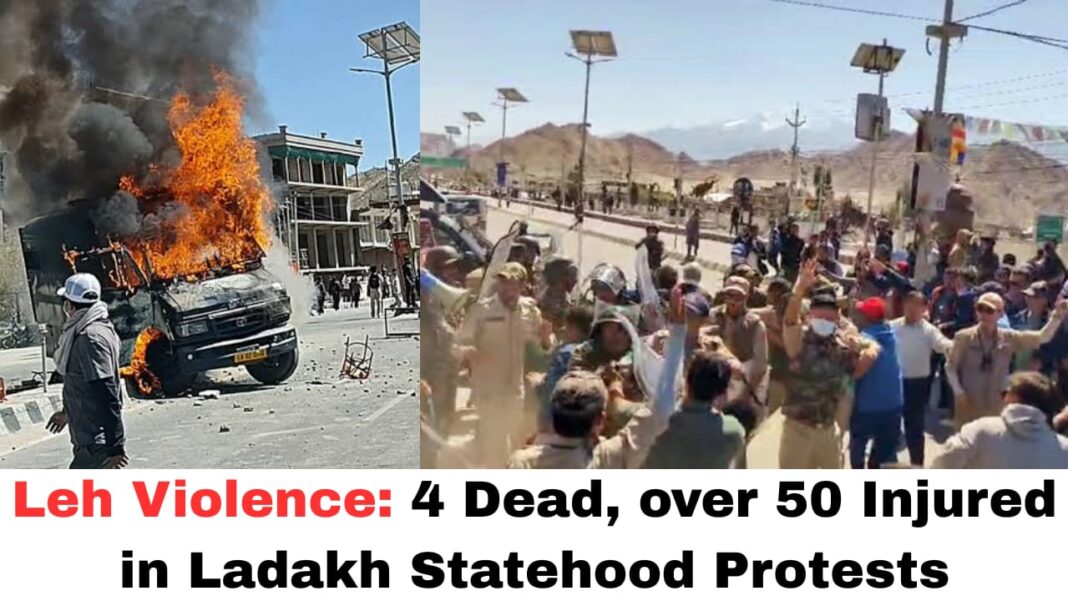Digital News Guru Ladakh Desk:
Leh Unrest: Statehood Protests in Ladakh Turn Violent, Claim Four Lives
Leh, Ladakh — On Wednesday, September 24, 2025, Leh witnessed one of its deadliest episodes of civil unrest in recent memory. At least four people were killed and dozens more injured amid clashes between protesters demanding statehood for Ladakh and security forces. The violence, triggered by deteriorating health of hunger strikers, quickly spiralled into arson, stone-pelting, and a harsh security response.
Triggers & Demands
The protests stem from a long-standing political movement led by residents of Ladakh, particularly the youth wings of the Leh Apex Body (LAB) and the Kargil Democratic Alliance (KDA). Their key demands include:
- Granting statehood to Ladakh, elevating its status from a Union Territory to a full state, giving it more governance autonomy.

- Inclusion under the Sixth Schedule of the Indian Constitution, which provides special constitutional protections and greater local self-governance for tribal areas.
- Separate Lok Sabha (parliamentary) representation for Leh and Kargil, to better reflect the region’s diverse geography and population.
- Reservation of government jobs to local residents and similar measures aimed at protecting ecological, cultural, and economic interests of the people.
The immediate spark was the hospitalisation of two hunger strikers — Tsering Angchuk (72) and Tashi Dolma (≈60-62) — after their health deteriorated on Tuesday evening. These hunger strikers had been engaged in a prolonged fast (one version says 35 days) since around September 10. The fast was part of the peaceful protest strategy.
Prominent activist Sonam Wangchuk, who had been leading a hunger strike for 15 days, called it off following the violent turn of events. He appealed for peace, urging the youth not to damage the cause through violence.
The Day of Violence
The protest movement had earlier called for a shutdown (bandh) in Leh as a show of strength. On Wednesday:
- Large crowds gathered, many moving from sites like the NDS Memorial Ground to other parts of Leh.
- As tensions rose, protesters allegedly pelted stones at police forces
- Some protesters set fire to a local BJP office and a police/security vehicle.
- Police responded with teargas, baton charges, and reportedly firing. The precise nature of the firing — whether warning shots or live rounds — is under dispute.
By evening, curfew measures were in place in Leh district. Authorities invoked Section 163 of the Bharatiya Nagarik Suraksha Sanhita (BNSS), 2023, which prohibits assemblies of five or more people. Prohibitory orders were issued to prevent further escalation.
Casualties & Aftermath
- Officials report four fatalities among the protesters.
- Number of injured ranges between 45 to 80+, depending on the reports, including police and paramilitary personnel. Some of the injured are in critical condition.
- Damage to property includes torched vehicles (including police/security vehicles), and the BJP’s local office was set ablaze.

Government & Administration Response
- Curfew and prohibitory orders: The Leh administration imposed curfew across Leh district and invoked BNSS Section 163 to ban assemblies, processions, and public gatherings.
- Security deployment: Additional police and paramilitary forces were mobilised to maintain order and secure key installations.
- Official statements: Lieutenant Governor Kavinder Gupta attributed the violence to “vested interests” and warned of strict action against those responsible.
- Dialogue promised: The Union Home Ministry noted that talks between the Centre and representatives from Leh (LAB) and Kargil Democratic Alliance (KDA) have been ongoing. A formal next round of negotiations has been scheduled for October 6.
Deeper Much: Underlying Grievances
While the violent turn of events shocked many, several deeper issues had been building up for years:
- After the abrogation of Article 370 in August 2019, Ladakh was carved out of Jammu & Kashmir and made a Union Territory, directly controlled by the Centre. This removed its prior semi-autonomous status, but key political promises remain unfulfilled.
- Residents have expressed fears of land exploitation, ecological damage, loss of traditional rights, inadequate local employment, and lack of political representation.
- The desire for protections under the Sixth Schedule is tied to safeguarding tribal rights and local self-rule, especially in environmentally sensitive high-altitude areas.
Implications & What Lies Ahead
The Leh clashes mark a significant turning point:
- Erosion of faith in peaceful protest: When activists like Sonam Wangchuk declare hunger strikes and peaceful protests, but see limited visible action, frustrations among younger protesters may lead to more confrontational strategies. Wednesday’s events reflect that tipping point.
- Political cost: For the administration (both local and central), there will be pressure to respond decisively—not just with force, but with policy. If demands are ignored, this unrest could intensify. Elections, local representations, jobs—all these will likely become even hotter topics.

- Risk of escalation: With curfews, bans on gatherings, and heightened security presence, there is always the risk that further protests could be met with pre-emptive restrictions, which may in turn fuel resentment.
- Need for clarity: Clear, time-bound steps from the government—on statehood roadmap, constitutional safeguards, and political representation—are likely necessary to deescalate. The October 6 meeting is being watched closely.
- Social & ecological stakes: Ladakh’s environment is fragile—glaciers, water sources, ecosystems—many of which are under threat from climate change, neglect, or unplanned development. The protesters argue that political neglect exacerbates ecological vulnerability. If governance fails to protect these, the demands won’t just be political: they’ll be existential.
Conclusion
The events of September 24 in Leh are a stark reminder of how deferred demands and perceived neglect can ignite even communities that have long chosen non-violent protest. For Ladakh, the stakes go beyond statehood; they encompass culture, environment, identity, and trust in democratic governance. As the government prepares for talks, what both sides agree on seems clear: the path forward must involve accountability, listening, and a framework ensuring that promises lead to tangible outcomes—not just rhetoric.
You May Also Read: India’s Only Active Volcano—Barren Island Erupts Twice in September 2025








